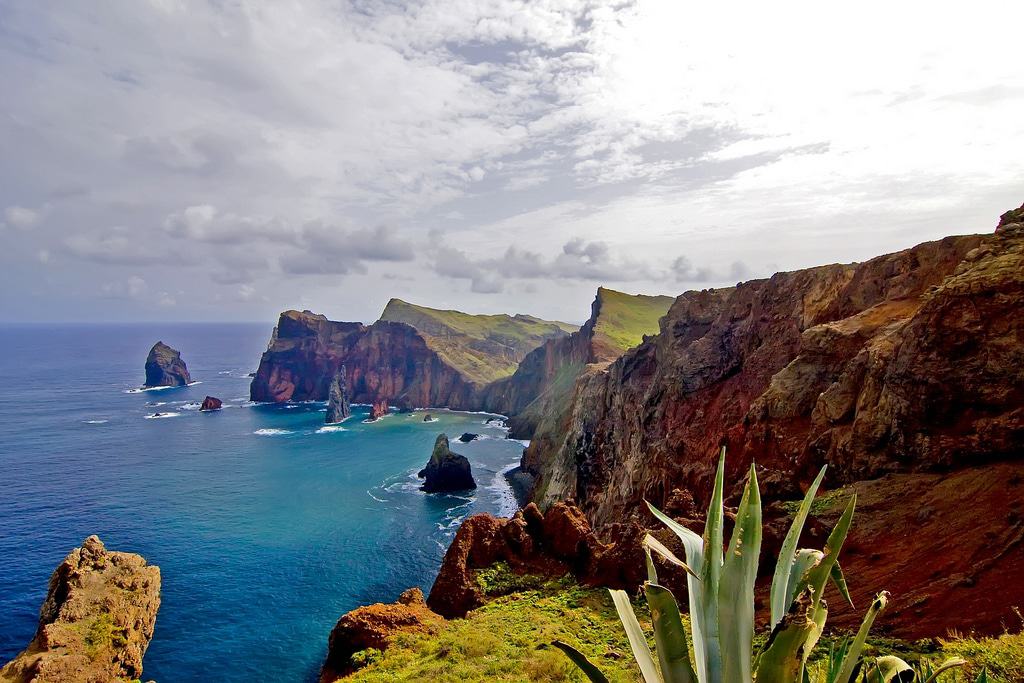Summary
When you find yourself in the distant Atlantic Ocean, positioned along the same latitude as North Africa, you may encounter unexpected elements typical of a European region.
The Madeira Archipelago boasts subtropical laurel forests nourished by a consistently mild climate and soils that support an array of flora.
The landscapes of Madeira are truly awe-inspiring, with accessibility via mountain roads or historical irrigation channels known as “levadas.” Furthermore, the island provides an abundance of botanical gardens showcasing diverse plant species.
The surrounding ocean offers opportunities for whale-watching excursions and diving in crystal-clear, temperate waters.
Let us explore the top activities in Madeira:
1. Ponta de São Lourenço

Located at the extreme east of Madeira, this nature reserve features vast volcanic rocks displaying striking reddish tones.
The hike is undoubtedly rewarding due to the breathtaking views of the Atlantic and the photographic opportunities that seem to portray the ends of the Earth.
Additionally, the unique soil and climate contribute to the flourishing of exotic flowering plants such as cardoons and everlastings.
Beyond the recently constructed Quinta do Lorde resort, human presence is minimal, with only sporadic picnic areas along the route.
Awe-inspiring vistas await at every turn leading to viewpoints such as the remarkable Ponta do Furado.
2. Cabo Girão

In 2012, a “skywalk” was constructed on this 580-meter-high cliff along Madeira’s southern coast.
This attraction is specifically for those who are not afraid of heights, as the platform extends beyond the cliff’s edge, featuring glass floor tiles providing a dizzying view of the ocean below.
For those who enjoy such experiences, the best part is that it is completely free.
As you peer downward, you will observe small farms lining the narrow strip of land between the cliff and the ocean.
The eastern side of the platform presents stunning views of Funchal.
3. Pico Ruivo

For those seeking an adventurous experience, Madeira’s highest peak (1,862m) is accessible with appropriate footwear and awareness of weather conditions.
The trail for experienced hikers commences at the Pico do Arieiro and takes approximately six hours to complete.
Although shorter and more manageable routes exist, such as from Achada do Teixeira, this trail offers the most stunning scenery.
The magnificent views along the path and at the summit are challenging to articulate.
On the trail, rocky mountain landscapes are adorned with green mosses, ferns, and heather, providing ample opportunities to capture images of local wildlife.
4. Levada Walks

The island’s geography indicates that most precipitation occurs in the northern and northwestern regions, whereas the southeast may experience dryness.
Consequently, beginning in the 1500s, various channels were ingeniously crafted along winding upland paths to transport water to drier regions, inspired by Moorish techniques.
These irrigation channels have transformed previously inaccessible locations into accessible pathways.
One of the finest routes, the Levada dos 25 Fontes, guides you past the spectacular 100-meter Risco Waterfall.
Moreover, the Levada do Caldeirão Verde, originating from the 1700s, channels water from the highest peaks of Madeira to Faial, traversing the enchanting São Jorge Valley.
5. Funchal Cable Car

Following the path of an old steam railway, a modern cable car system transports visitors from Almirante Reis to the upper suburb of Monte in Funchal.
Although queues are common, they progress quickly, offering approximately 15 minutes to appreciate stunning views of the ocean and terraced mountainsides dotted with white structures.
The trip is worthwhile for a variety of reasons, from beautiful vistas to the Monte Palace Tropical Garden or the Church where Emperor Charles I is interred.
Once at the top, an amusing surprise awaits: individuals dressed in white attire and boater hats will usher you into a basket for a toboggan ride back down to Funchal.
6. Panoramic Drives

One remarkable factor about Madeira is that despite its challenging terrain, the road infrastructure is comprehensive.
These routes meander through breathtaking natural landscapes, providing an alternative to arduous hikes.
Many of these roads were constructed at significant expense and took years to complete.
The VE2 coastal route from São Vicente to Porto Moniz is particularly noteworthy, featuring continuous ocean views and hugging the verdant cliffs.
Waterfalls can be found along the way, and a detour to Seixal allows for a refreshing dip in the natural rock pools.
The winding road leading from Funchal to Curral das Freiras, situated deep within Madeira’s interior, is equally astounding and only takes about half an hour.
7. Parque Forestal de Queimadas

Nestled in the lower reaches of Pico Ruivo, an enchanting subtropical laurel forest can be found.
The region’s high humidity envelops the woodland in a light mist and covers the forest floor with moss, lichens, and ferns, some of which possess the largest fronds in Europe.
A network of trails provides access to multiple Levadas. Additionally, visitors may opt to enjoy a picnic at a shelter designed like a traditional Santana cottage, complete with a thatched roof and timber framing.
8. Monte Palace Tropical Garden

Upon exiting the cable car terminal in Monte, visitors are greeted by the entrance to these stunning gardens.
These gardens are elegantly arranged along the terraced slopes surrounding the former Monte Palace Hotel, built in a Rhenish Revival style at the dawn of the 20th century.
Within the gardens, one can find medicinal plants, herb beds, cacti, heather from Scotland, European azaleas, local laurel forests, and cycads from South Africa.
A pause in the Japanese garden reveals a pagoda and a koi pond, adding to the garden’s allure.
Additionally, azulejos integrated amidst the foliage provide a spectacular depiction of Portuguese history in Japan, displayed on a large panel of 166 tiles.
9. Vereda dos Balcões

A parking area is conveniently located just off the ER 103 at Ribeira Frio, providing access to the Levada da Serra do Faial and embarking on a hike to this remarkable vantage point.
The stunning destination is matched by an unforgettable journey through forests filled with orchids, Madeira mahogany, and Madeira blueberries, alongside various exotic species such as plane trees and English oaks.
The viewpoint serves as the perfect conclusion, offering a breathtaking perspective of a mist-laden mountain cirque in the Metade Valley.
In the distance, sharp peaks transition into rolling hills covered in agricultural crops.
10. Madeira Film Experience

This film is screened in a comfortable cinema near the marina and compresses six centuries of Madeira’s history into a concise 30-minute presentation.
The audioguide system provides commentary in various languages, including English, French, German, Dutch, and Portuguese.
While one might question the inclusion of a video presentation in a list of experiences, it serves as an excellent introduction to the archipelago, imparting essential knowledge about its 15th-century discovery, wars, famine, and revolutions.
For visitors disembarking from a cruise ship, this can be a beneficial first stop, allowing them to glean insights and feel well-informed about the region.
11. Palheiro Gardens

Situated 500 meters above the Atlantic, in the lush hills just east of Funchal, these gardens at the Quinta do Palheiro estate demonstrate the adaptability of numerous plants in Madeira’s fertile soil.
Since 1885, the estate has been under the stewardship of the Blandy family, who have longstanding ties to the island’s wine industry.
Previously, it belonged to Conde do Carvahal, a Portuguese nobleman who initiated the gardens’ notable collection of camellias.
Visitors may admire whimsical topiaries, roses, cypresses, and, due to the island’s spring-like climate, witness vibrant blooms from hibiscus and bougainvillea throughout the year.
12. Diving

Madeira has become a premier diving destination in Europe.
This reputation can be attributed to exceptional water clarity and minimal temperature fluctuations.
The coldest water temperature measures 18°C in February, significantly warmer than many locations in Europe during summer; peak season in August and September typically sees comfortable temperatures around 24°C. Consequently, if you are contemplating a SSI or PADI course, Madeira is an ideal location.
It is truly a privilege to witness marine species that you would generally only find through online research. While exploring underwater, you may encounter grouper, octopus, and moray eels nestled among the rocks.
Most dive centers also arrange excursions to the Savage Islands, where swimmers can engage with monk seals, dolphins, and turtles.
13. Boat Trips

Numerous companies offer excursions into the ocean for the purpose of whale and dolphin watching.
Though sightings are not guaranteed, skilled skippers are familiar with the waters and know how to identify signs indicative of nearby cetaceans.
For example, a sudden flock of seabirds typically indicates that marine mammals are in the vicinity.
Approximately 20 species of dolphins and whales have been observed off the coast of Madeira, representing over a fifth of all species in the wild.
Summer is the optimal season for such tours; with a bit of luck, you might spot pilot whales, sperm whales, and Bryde’s whales, while bottlenose and spotted dolphins are frequently seen throughout the year.
14. Madeira Whale Museum

Located in Caniçal on the eastern coast, this museum chronicles the history of whaling in Madeira.
Whaling expeditions were launched from Caniçal as recently as 1981. Opened in 1989 and renovated in 2011, the museum offers a candid exploration of the whaling industry, featuring tools, vessels, and firsthand accounts.
This has considerable ethnographic significance, as it reflects a way of life that has now become historical in Madeira.
The museum also includes a section dedicated to cetacean conservation, featuring life-sized replicas of whales and dolphins, alongside 3D footage showcasing these marine mammals.
15. Madeira Wine

Upon arrival in Funchal, it is essential to familiarize yourself with Madeira’s renowned fortified wine.
Depending on its quality, this wine may have aged under specific warm conditions for years, with some vintages being available that are over a century old. Blandy’s Wine Lodge serves as an excellent starting point, illustrating 200 years of winemaking history on the archipelago.
Participating in a premium tour and tasting experience provides insight into the cooperage process—where barrels are crafted, the transformation of negra mole grapes into wine, and the use of Brazilian satinwood for aging vats.





